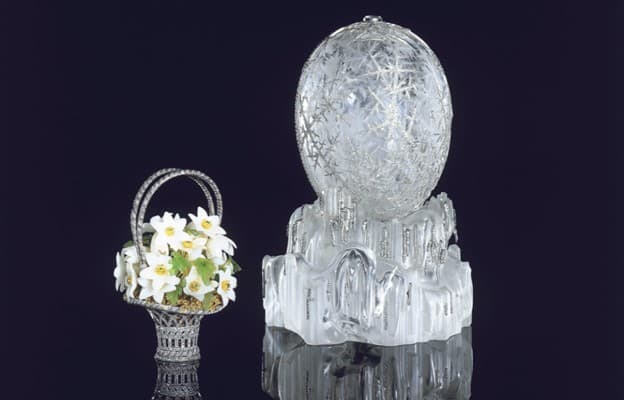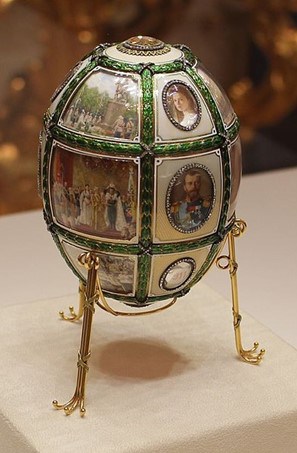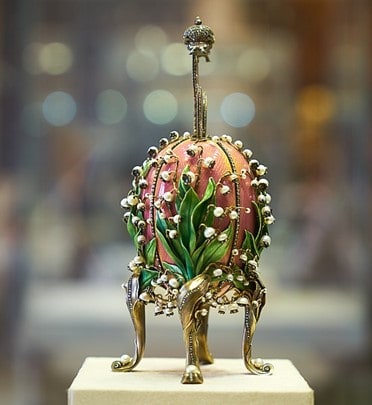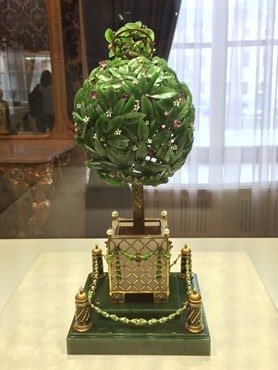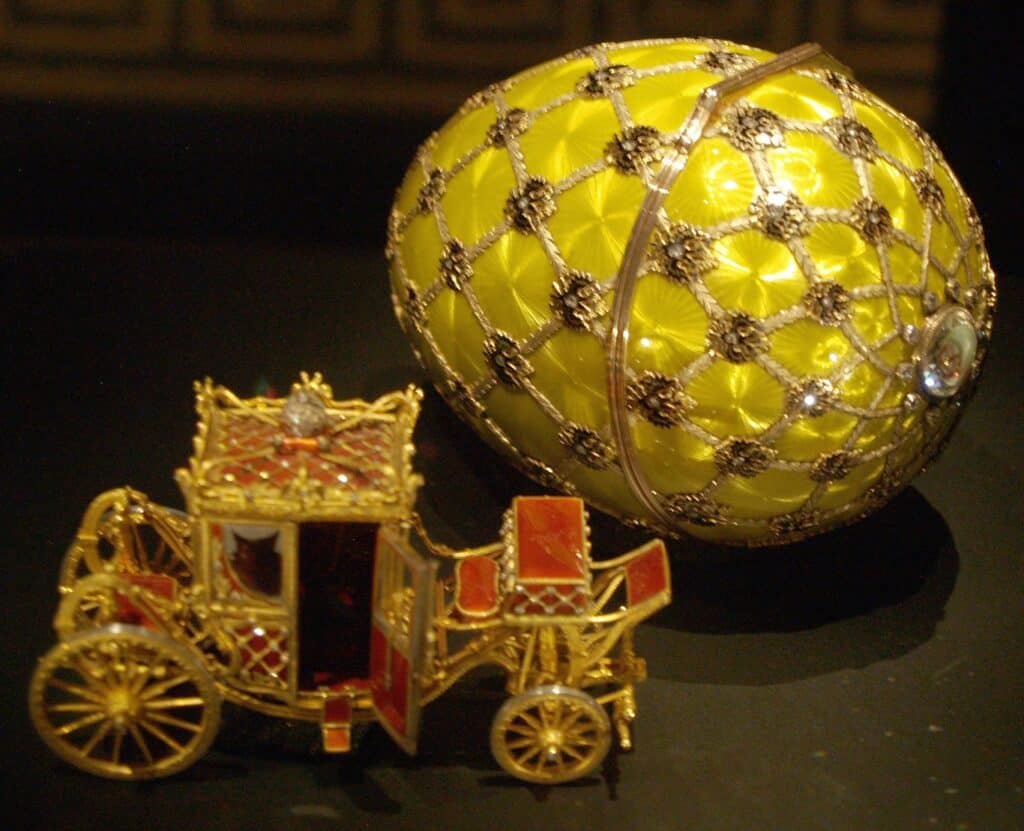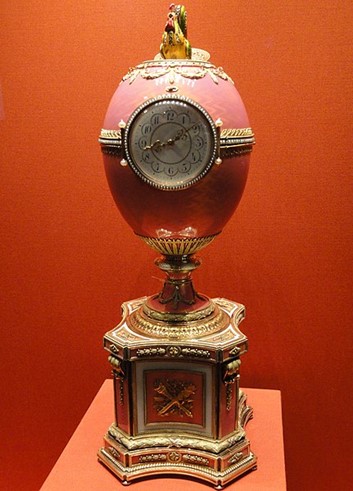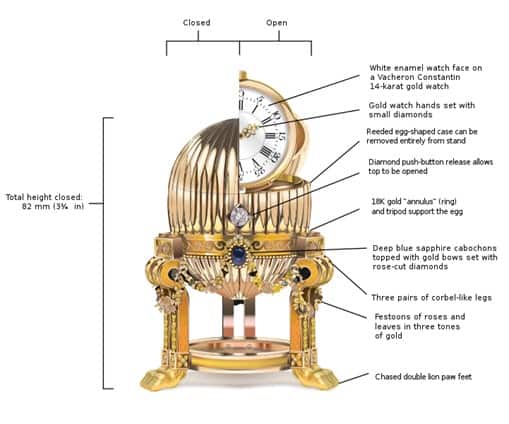The history of the Fabergé egg began in the late-1800s with the Russian royal family’s love of artisanship and pretty things. Tsar Alexander III commissioned the craftsman Peter Carl Fabergé to create a jeweled egg for the Empress Maria Feodorovna, his wife. The symbol of the egg is a reference to being an Easter gift. The eggs were adopted as an annual tradition in the family after that. A total of 50 of these original eggs were created and around 43 of them still survive (that we know about).
To learn more about the history of the incredible Fabergé eggs and the value of the 8 most expensive Fabergé eggs today, continue reading.
- Fabergé The Sapphire Diaghilev Egg
- The Winter Egg
- The Fifteenth Anniversary Egg
- The Lilies of the Valley Egg
- The Bay Tree Egg
- The Imperial Coronation Egg
- The Rothschild Egg
- The Third Imperial Easter Egg
Year: 2010
Customer: N/A

photo source: 1stdibs
Before getting into the historical Fabergé eggs, those that are considered the “true” Fabergés made in the workshop’s history between 1885 and 1917, we wanted to list the most valuable that you can buy today. Yes, Fabergé is still around, in a sense, and still makes jeweled eggs for royal contracts with clients like Victoria & Albert.
The Sapphire Diaghilev Egg by Fabergé is sold online for $308,389.77.
Did you know?
Following the Russian Revolution, the house of Fabergé made a move out of Russia to Paris. This was 1918, marking the end of the true Fabergé period in Russia. Modern Fabergé is not the same workshop, but actually a beauty products company who adopted the name, authorized by the real Fabergés in 1951 to use the name.
Year: 1913
Customer: Nicholas II

photo source: Christie’s
The Winter Egg was commissioned in 1913 by tsar Nicholas II, making it one of the newest Fabergé eggs made in the official workshop. It was commissioned for the Danish princess, Maria Feodorovna, the wife of Emperor Alexander III.
Costing 24,700 rubles when it was commissioned, it was the most valuable egg at the time. However, today its newer date puts it further back on this list behind the older eggs. The egg has sold for $7.8 million in 1994 and then again at another Christie’s auction in 2002 for $9.6 million.
Unlike the majority of eggs on this list, the Winter Egg is not owned by the Russian oligarch Viktor Vekselberg but is instead in a private royal collection in Qatar.
Did you know?
Unlike the eggs on this list designed by Fabergé himself, the Winter Egg was made by Alma Pihl, the best-known of the two female designers at Fabergé.
Year: 1911
Customer: Nicholas II

photo source: Wikimedia Commons
The Fifteenth Anniversary Egg is valued just below the price of its sister egg, the Bay Tree Egg, which we’ll talk about later. Like that egg, this one was commissioned in 1911 by tsar Nicholas II for his wife, the Empress Alexandra Feodorovna. The egg was sculpted from enamel (gold, white, and green), and is covered in diamonds.
The name comes from its use as a commemorative design to celebrate tsar Nicholas II’s coronation in 1896. The egg is valued at $12.5 million.
Did you know?
Unlike most of Fabergé’s eggs, the Fifteenth Anniversary Egg has no surprise inside. This was not commissioned by Tsar Nicholas without one – for an unknown reason, Fabergé just didn’t include his signature mechanism this time. However, the egg is unique in that its outside is a mosaic of 16 panels, each of which is a tiny panel portraying people and events in the tsar’s life.
Year: 1898
Customer: Nicholas II

photo source: Wikimedia Commons
The Lilies of the Valley Egg was made in 1898 by Fabergé himself, supervised by the master goldsmith, Michael Perchin. It was one of the many eggs commissioned by tsar Nicholas II, in this case for his wife, the Empress Fyodorovna. Other than Viktor Vekselberg, the Russian oligarch who now owns most of these valuable eggs, the Empress Fyodorovna saw more multi-million-dollar Fabergé eggs than anyone. The Lilies of the Valley egg is valued at $13 million.
Did you know?
The egg is cloaked in pearls, rubies, and diamonds, green-gold leaves, and dewdrops made from rose-cut diamonds. It is only one of two eggs known to be made in the Art Nouveau Style (the other being the Pansy Egg). This short-lived style was popular between 1890 and 1910 and prioritized dynamic movements of nature, including flowers and curves, as a rebellion against the hard-edged ornamentations of the Baroque and Neoclassical styles.
Year: 1911
Customer: Nicholas II

photo source: Wikimedia Commons
One of the many eggs on this list commissioned by tsar Nicholas II, the Bay Tree egg, which is also sometimes referred to as the Orange Tree egg due to its shape, is one of the most valuable Fabergé eggs in the world. The egg is sculpted from nephrite, which is a luminous blue-green stone that Fabergé enameled and then jeweled.
Tsar Nicholas II presented this egg to the Dowager Empress Maria Feodorovna, who happens to be his mother, in 1911. It is currently owned by Viktor Vekselberg and displayed at the Fabergé Museum in St. Petersburg, valued at $15 million.
Did you know?
The jewels embedded into the green and white enamel, gold, and nephrite egg include diamonds, amethysts, pearls, citrines, and rubies.
Year: 1897
Customer: Nicholas II

photo source: Wikimedia Commons
The Imperial Coronation Egg is a Fabergé egg commissioned by tsar Nicholas II in 1897 for Alexandra Fyodorovna, as we’re sure you’re used to hearing by now. The egg has been exhibited many times at the Hermitage Museum in St. Petersburg. The billionaire Viktor Vekselberg owns the egg now, though he lends it out to exhibitions.
He acquired the egg in 2004, currently valued $18 million.
Did you know?
The Imperial Coronation Egg is sculpted from gold and yellow enamel, rhythmically engraved in a starburst pattern to mirror the golden robe that Tsarina Fyodorovna wore at her coronation. It has green-tinted gold laurel leaves enrobing an enamel double-headed eagle. On top, it has a portrait diamond made from a pattern of ten diamonds. The flower pattern continues over the egg’s surface and includes multiple diamond and rose diamond portraits.
Year: 1902
Customer: Béatrice Ephrussi de Rothschild

photo source: Wikimedia Commons
The Rothschild Egg was commissioned in 1902 for Béatrice Ephrussi de Rothschild, borrowing the socialite’s name for itself. This egg is enameled and encrusted with gold and jewels and was given as a gift to Germaine Halphen upon the occasion of her engagement to Édouard Alphonse James de Rothschild, Béatrice’s brother.
At the top of each hour, a cockerel set with diamonds emerges from the eggs, flaps its mechanical wings and head, and waits for the bell to chime. The Rothschild Egg is one of only four known to have clock-based ornamentation. It was acquired by the Hermitage Museum in St. Petersburg, Russia in 2014 and is now valued at $25 million.
Did you know?
Very few multi-million-dollar Fabergé eggs were crafted for patrons other than the Russian Imperial family of the period. The Rothschild Egg was designed by the jeweler Michael Evlampievich Perkhin who was one of the two imperial workmasters for the House of Fabergé in the late 1800s.
Year: 1887
Customer: Alexander III

photo source: Wikimedia Commons
The most expensive Fabergé egg is the Third Imperial Easter Egg. This legendary creation came from the workshop of the artisan Peter Carl Fabergé himself, commissioned for Alexander III, the Russian tsar, as an Easter present for his wife, Maria Fyodorovna.
The egg is made from solid 18-karat gold. Its corbel legs and lion paw feet are clustered in gold-sculpted roses and leaves, encrusted in cabochon sapphires and diamonds. The egg’s front has a diamond clasp that can be pressed to reveal the surprise inside, which is a Vacheron-Constantin lady’s watch. The egg was thought lost until rediscovered in 2012, most astoundingly by a flea market scrap metal dealer who recognized its value and bought it for $14,000. The dealer then sold the egg to a private collector in 2014. Its value is estimated at $33 million, making it the world’s most expensive Fabergé egg.
Did you know?
The Third Imperial Easter Egg was sculpted in the Louis XVI Style, which is the infamous architectural style of Louis XVI (1774-1793). The style bridged the gap between the tail-end of the Baroque art style and the start of the French Neoclassical era. The style favored simplicity over ornament, comparatively, inspired by the philosopher Rousseau’s love of nature and order. This Fabergé egg exemplifies this meeting of styles.
The Takeaway
Nothing says luxury gift-making and Russian heritage quite like the luxurious Fabergé eggs. Encrusted in jewels and precious stones, sculpted from gold, coated in enamel, and built with stunning mechanisms known as their “secret,” these eggs are now valued in the tens of millions of dollars. You’ll likely have to go to one of the eggs’ many exhibitions at Russian history museums to see one of these incredible creations in person. For now, this list will have to do!


